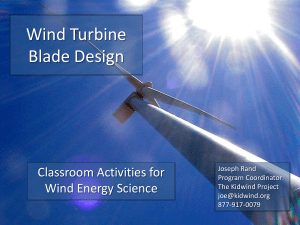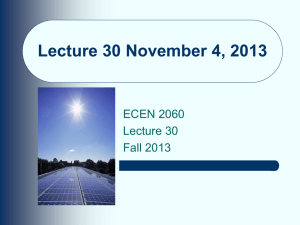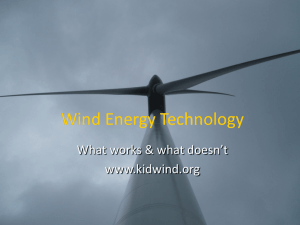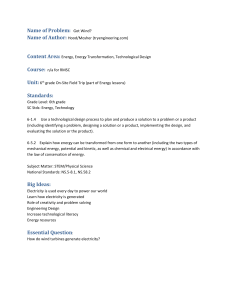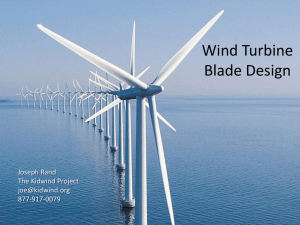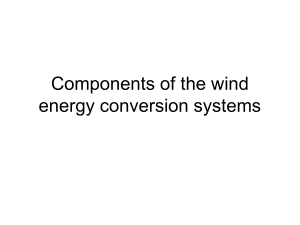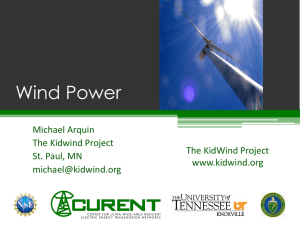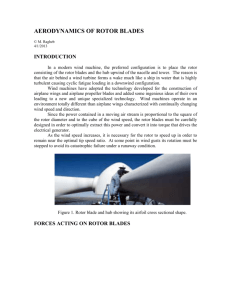Modern Wind Energy and its Origins
advertisement
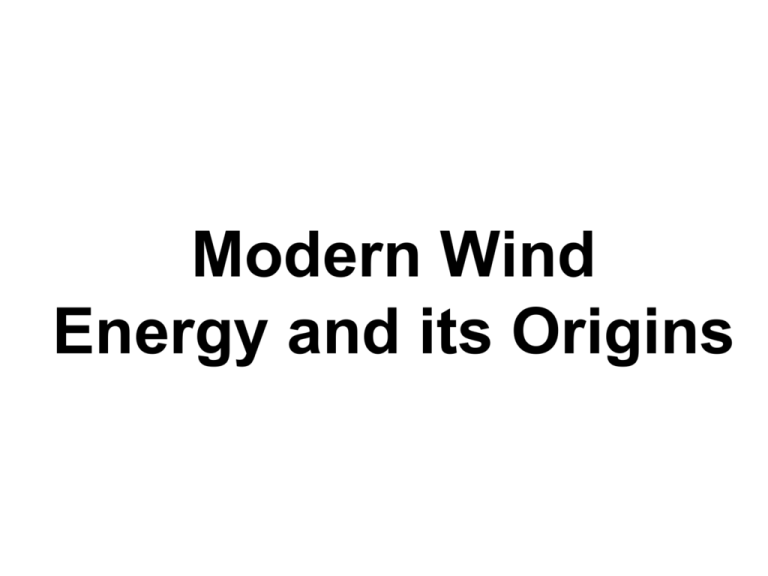
Modern Wind Energy and its Origins U.S. Use of Renewable Energy Source: Annual Energy Review 1999, U.S. Energy Information Administration. What Makes Wind Global Wind Patterns Wind Energy History • • • • • • • • 1 A.D. (Anno Domini, or “The Year of Our Lord”) – Hero of Alexandria (a Greek mathematician) uses a wind machine to power an organ ~ 400 A.D. – Wind driven Buddhist prayer wheels 1200 to 1850 – Golden era of windmills in western Europe – 50,000 – 9,000 in Holland; 10,000 in England; 18,000 in Germany 1850’s – Multiblade turbines for water pumping made and marketed in U.S. 1882 – Thomas Edison commissions first commercial electric generating stations in NYC and London 1900 – Competition from alternative energy sources reduces windmill population to fewer than 10,000 1850 – 1930 – Heyday of the small multiblade turbines in the US midwast • As many as 6,000,000 units installed 1936+ – US Rural Electrification Administration extends the grid to most formerly isolated rural sites 5 • Grid electricity rapidly displaces multiblade turbine uses 6 Manufacturing Market Share Source: American Wind Energy Association 7 WindEnergy Energy Capacity US U.S. Wind Capacity 10000 8000 6000 MW 4000 2000 0 2000 2001 2002 2003 2004 2005 8 Orientation Turbines can be categorized into two overarching classes based on the orientation of the rotor Vertical Axis Horizontal Axis KidWind Project | www.kidwind.org Vertical-Axis Turbines Advantages Disadvantages o Omni-directional - accepts wind from any direction o Components can be mounted at ground level - ease of service - lighter weight towers o Can theoretically use less materials to capture the same amount of wind o Rotors generally near ground where wind is poorer o Centrifugal force stresses blades o Poor self-starting capabilities o Requires support at top of turbine rotor o Requires entire rotor to be removed to replace bearings o Overall poor performance and reliability Horizontal-Axis Wind Turbines Small (<10 kW) Intermediate(10-250 kW) oVillage Power oHomes oHybrid Systems oFarms oDistributed Power oRemote Applications (e.g., water pumping, Telecom sites, ice making) Large (250 kW-2+ MW) oCentral Station Wind Farms oDistributed Power oSchools Recent Capacity Enhancements 2000 850 kW 265’ 2006 5 MW 600’ 2003 1.8 MW 350’ 13 Large Wind Turbines Common Utility-Scale Turbines 328’ base to blade Each blade is 112’ 200 tons total Foundation 20’ deep Rated at 1.5-2 megawatts o Supply about 500 homes o o o o o Wind Turbine Components Horizontal Axis Wind Turbines • Rotors are usually Up-wind of tower • Some machines have down-wind rotors, but only commercially available ones are small turbines How a Wind Turbine Operates The NEED Project 2014 Airfoil Nomenclature wind turbines use the same aerodynamic principals as aircraft KidWind Project | www.kidwind.org Lift & Drag Forces • The Lift Force is perpendicular to the direction of motion. We want to make this force BIG. • The Drag Force is parallel to the direction of motion. We want to make this force small. α = low α = medium <10 degrees α = High Stall!! Apparent Wind & Angle of Attack ΩR Ωr α V V VR = Relative Wind α = angle of attack = angle between the chord line and the direction of the relative wind, VR . VR = wind speed seen by the airfoil – vector sum of V (free stream wind) and ΩR (tip speed). Tip-Speed Ratio Tip-speed ratio is the ratio of the speed of the rotating blade tip to the speed of the free stream wind. There is an optimum angle of attack which creates the highest lift to drag ratio. Because angle of attack is dependant on wind speed, there is an optimum tip-speed ratio ΩR TSR = V Where, Ω = rotational speed in radians /sec R = Rotor Radius V = Wind “Free Stream” Velocity ΩR ΩR RR Performance Over Range of Tip Speed Ratios • Power Coefficient Varies with Tip Speed Ratio • Characterized by Cp vs Tip Speed Ratio Curve 0.4 Cp 0.3 0.2 0.1 0.0 0 2 4 6 8 Tip Speed Ratio 10 12 Twist & Taper • Speed through the air of a point on the blade changes with distance from hub • Therefore, tip speed ratio varies as well • To optimize angle of attack all along blade, it must twist from root to tip Pitch Control vs. Stall Control • Pitch Control – Blades rotate out of the wind when wind speed becomes too great • Stall Control – Blades are at a fixed pitch that starts to stall when wind speed is too great – Pitch can be adjusted for particular location’s wind regime • Active Stall Control – Many larger turbines today have active pitch control that turns the blades towards stall when wind speeds are too great Airfoil in stall • Stall arises due to separation of flow from airfoil • Stall results in decreasing lift coefficient with increasing angle of attack • Stall behavior complicated due to blade rotation Rotor Solidity Solidity is the ratio of total rotor planform area to total swept area R Low solidity (0.10) = high speed, low torque a A High solidity (>0.80) = low speed, high torque Solidity = 3a/A Number of Blades – One • Rotor must move more rapidly to capture same amount of wind – Gearbox ratio reduced – Added weight of counterbalance negates some benefits of lighter design – Higher speed means more noise, visual, and wildlife impacts • Blades easier to install because entire rotor can be assembled on ground • Captures 10% less energy than two blade design • Ultimately provide no cost savings Number of Blades - Two • Advantages & disadvantages similar to one blade • Need teetering hub and or shock absorbers because of gyroscopic imbalances • Capture 5% less energy than three blade designs Number of Blades - Three • Balance of gyroscopic forces • Slower rotation – increases gearbox & transmission costs – More aesthetic, less noise, fewer bird strikes Wind Turbine Perspective Workers Blade 112’ long Nacelle 56 tons Tower 3 sections The NEED Project 2014 Wind Farms Potential Impacts and Issues Property Values Noise Visual Impact Land Use Wildlife Impact Properly siting a wind turbine can mitigate many of these issues. Impacts of Wind Power: Noise The NEED Project • Environmental benefits • No emissions • No fuel needed • Distributed power • Remote locations Limitations of Wind Power Power density is very low. Needs a very large number of wind mills to produce modest amounts of power. Cost. Environmental costs. material and maintenance costs. Noise, birds and appearance. Cannot meet large scale and transportation energy needs. Wind Turbine Noise Levels The Future of Wind Energy Future of wind energy can be bright if government policies subsidize and encourage its use. Technology improvements unlikely to have a major impact. Can become cost competitive for electricity generation if fossil energy costs skyrocket.

